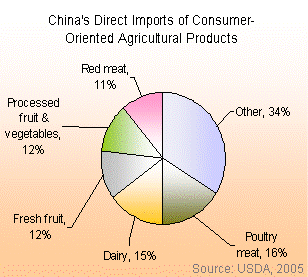 |
 |
|
|
|
|
|
|
|
|
|
|
|
|
|
|
|
|||||||||
|
|
|
|
|
|
|
|
|
|
|
|
|
|
|
|
|
|
|
|
|
|
|
|
|||||||||||||||||||
|
|
|||||||||||||||||||
|
Food is a national obsession and an essential part of Chinese culture and social life. Major life events revolve around food and while the average Chinese is price conscious and conservative, little expense is spared for food related gifts, entertainment and events.
The food consumption trend is for more meat, aquatic products, dairy products, convenience read-to-eat/cook meals and fresh and health foods. The Chinese consumers are becoming more health conscious and foods that have health properties for the young and old to help resist disease development, improve mental and physical strength, sex drive, endurance, intelligence, memory and physical appearance or reduce weight, will have a ready market. Western style food is becoming very popular in China – particularly fast foods and beverages such as McDonald’s burgers, Kentucky Fried Chicken, Starbucks coffee and PizzaHut. Many of the international food brands such as Coca Cola, Budweiser, Nestles, Heinz, Kraft and Peters are becoming household names. A majority of the Chinese have come to accept imported foods as being superior in quality and are more willing to pay a higher price for them.
Food retailing is undergoing significant changes from wet markets and corner shops to that of hypermarkets, supermarkets, departmental stores and convenience stores. Foreign retail chain giants such as Wal-Mart, Carrefour and Metro are now well established in China. Food consumption through hotels, restaurants and institutional food outlets is booming. This rapid growth is driven by the emergence of large middle class 2-income families and the Chinese tradition of hospitality and dinning out.
Branding,
presentation, packaging design and size, quality, varieties, shelf life,
safety and reliability are now important ingredients for marketing success.
The Chinese consumers are becoming more style conscious and sensitive to
evolving trends and fads and will spend money to experiment new foods.
|
There are tremendous opportunities in the area of processed food as only a small proportion of the food production in China is processed. China currently processes about 25% of its food production compared to 90% in developed countries such as Australia and US. The Chinese food market is immense but complicated as food preferences and usages are constantly evolving and can vary significantly from region to region, culture to culture, between urban and rural populations, age groups, and affordability.
|
||||||||||||||||||
|
In view of the vast business potential in China, businesses worldwide are actively searching for ways and means to access China’s vast market. However, while tremendous opportunities exist in the huge Chinese agrifood market, accessing and turning those opportunities into reality is not easy.
Unless you have a product or service that sells itself, having a quality product or service at a competitive price does not necessary translate into instant success in China. The average foreign organization or company would still be required to spend considerable financial and |
AgrifoodAsia can minimize your chance of disappointment and lost opportunities, and save you time, money and effort by providing you with our extensive China business structures, mechanisms, networks, expertise and experience, and equip you with the skills necessary for you to DO and MAKE business HAPPEN in China through our training program.
Please browse our Partner and Business Centres for more information on how we can work with you to make business happen for you. |
||||||||||||||||||
|
|
![]()
![]()


 The
average Chinese spends more than 40% of disposable income on food and
beverages. It is forecast that the Chinese food and beverage market in
2005 will be valued at approximately A$350 billion and will increase at a
rate of more than 10% per year for the next decade. The affluence of the Chinese
consumer is increasing rapidly as millions of Chinese join the middle class
each year. Even the poor will spend the equivalent of months or years of
salary to try food that is considered new, unique, exotic or have
significant health benefits.
The
average Chinese spends more than 40% of disposable income on food and
beverages. It is forecast that the Chinese food and beverage market in
2005 will be valued at approximately A$350 billion and will increase at a
rate of more than 10% per year for the next decade. The affluence of the Chinese
consumer is increasing rapidly as millions of Chinese join the middle class
each year. Even the poor will spend the equivalent of months or years of
salary to try food that is considered new, unique, exotic or have
significant health benefits.  National
food distribution in China is still a major problem due to poor
transportation, lack of a cold chain, fragmented marketing networks,
logistics, under developed agricultural production and postharvest management
systems, and regionalism. Totally foreign-owned manufacturing and
distribution is now possible and the market for foreign food products is
likely to expand rapidly over the next few years due to surging consumer
demand for greater quality and variety; improving distribution
infrastructure, food standards and regulatory environment, market access
liberalization, conformity to WTO agreements, and falling duties and taxes.
National
food distribution in China is still a major problem due to poor
transportation, lack of a cold chain, fragmented marketing networks,
logistics, under developed agricultural production and postharvest management
systems, and regionalism. Totally foreign-owned manufacturing and
distribution is now possible and the market for foreign food products is
likely to expand rapidly over the next few years due to surging consumer
demand for greater quality and variety; improving distribution
infrastructure, food standards and regulatory environment, market access
liberalization, conformity to WTO agreements, and falling duties and taxes.
 Major Business
Opportunities
Major Business
Opportunities